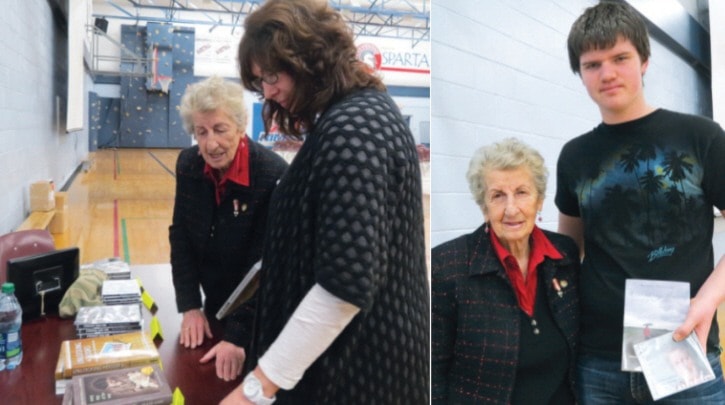When holocaust survivor Dr. Eva Olsson spoke at the Rimbey high school, the student body was strangely quiet, and during her dynamic presentation, it seemed one truly could have heard a pin drop, so riveting were her words.
Although her English was laced with a heavy accent, the 90-year-old survivor seemed to grab the attention of her audience immediately.
While Olsson talked, slides depicting surviving scenes of the holocaust played on a screen set up behind her.
“This is not a video game,” she said. “And it’s not a Hollywood movie.”
During her hour and a half presentation, Olsson took the students back to a time of horror, a time when unspeakable acts of bullying occurred at the hands of Nazi soldiers.
Several hands were raised when she asked the question “How many of you have been bullied?”
“I was 19 when they bullied me and I didn’t make a sound. I didn’t want to end up with a bullet in my back.”
Olsson stressed that the horrors of the holocaust were the result of hate in action.
“What was the cause of the holocaust?” she said. “It was one word – hate.”
Treating others with kindness and respect no matter what their race, religion or country of origin is a golden rule which needs to be strictly adhered to, she said.
“How can we achieve peace if we don’t accept each other?” she said. “You are being disrespectful to the country your ancestors came from (if you are a bully),” she said.
Anyone who watches bullying happen needs to take action, she said.
“Hitler could not have gotten away with what he did without bystanders,” she said. “The worst thing you can do is remain silent. Don’t remain silent or the bully will get away with it.’
Born in Szatmar, Hungary Olsson was one of six children of a poor Hasidic Jewish family.
As the war raged around them, the family was one of many families placed in a ghetto. Living conditions were primitive, but the young Eva still had her family around her.
“It was okay. I had a mom, dad, brothers, sisters.”
But on May 15, 1944 that all changed. The family was told to pack their bags and within two hours was forced to march seven kilometers from the ghetto to a railway station.
It proved to be the beginning of a nightmare that did not end until British and Canadian soldiers finally liberated the prisoners.
After being one of the Jews who survived a harrowing train ride where passengers fought for breath in packed box cars, Olsson found herself at Auschwitz-Birkenau – a Nazi death camp set up in occupied Poland.
In a voice sometimes breaking with emotion, Olsson told how a Nazi officer and physician known as the Angel of Death who, with a simple glance to the right or the left, decided who would live and who would die.
“It was a killing factory,” she said.
She was to find out later members of her family including her mother were killed in the gas chambers.
“My mother was 49 years old when she was murdered,” she said. “Who could do this? Animals!
“It was people with hate in their hearts,” she said.
As Olsson continued, the students remained riveted to their chairs, and all eyes were on the speaker.
The prisoners were forced into the gas chambers and the air was filled with their screams, but after 20 minutes it was all over and there was only silence, she said.
Her words and the images that flashed on the slides brought tears to some, as the horror was relived.
During her time in a slave labor camp, Olsson barely survived, living mostly on bread that was 70 per cent sawdust and dirty putrid water.
Like many of the other prisoners she became very ill with typhoid fever and dysentery and lay on a straw floor covered with human waste awaiting a certain death.
But even through the long dark days she never gave up hope and on April 15, 1945 at 11 a.m. four hours before prisoners were all to be shot, those who had survived in the slave labor camp were liberated by British and Canadian soldiers.
Olsson recalled how sick she was and how the medics had placed a red cross on her forehead, indicating she needed immediate attention.
After she recovered, she and her younger sister, the only surviving members of her family, went to Sweden as refugees. Eva would later marry Rude Olsson, a young Swede she met while living there, and move to Canada.
Olsson gave birth to twins, a boy and a girl, but only the baby boy survived.
Olsson’s husband later died of complications caused by a car accident.
As a single mother without family, education or job training and harboring the fear that her story could cause harm to come to her son, Olsson remained silent about her past for 50 years.
But her veil of silence was shattered when she spoke to her granddaughter’s elementary school class. That first speaking engagement led to countless presentations made at schools, colleges, universities and numerous groups and organizations.
She has also written numerous books.
“The only way humanity will survive is if me becomes we,” she said. “The only thing that affects every one of us is our attitude.”
“Unconditional love and acceptance of other human beings. Pass it on to other children,” she implored.
Grade 11 student Brendon Freerksen purchased one of Olssen’s books for his mother after the presentation. He said her talk was well worth hearing.
“It was unbelievable. It was a once in a lifetime experience.”
Eva Olsson was brought to Rimbey through the Rimbey Library. She also spoke at the Rimbey United Church and the elementary school.
